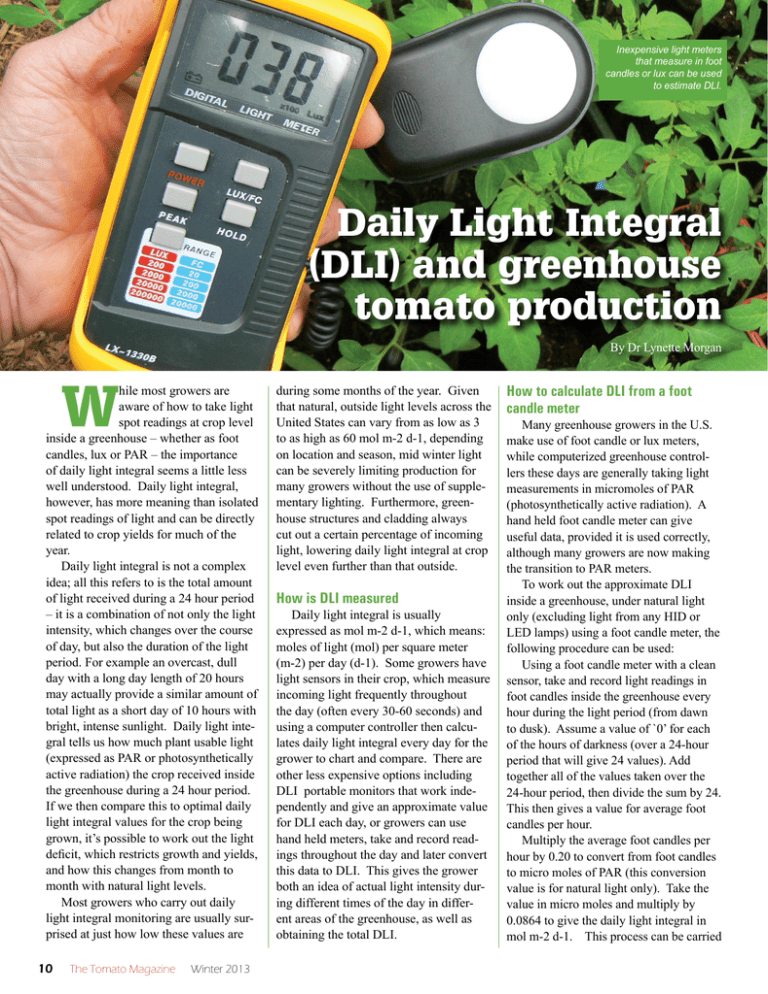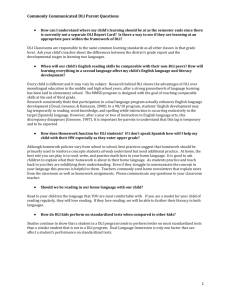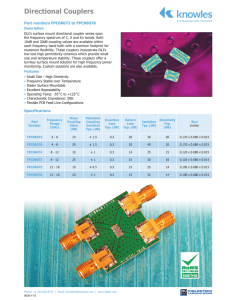Daily Light Integral (DLI) and greenhouse
advertisement

Inexpensive light meters that measure in foot candles or lux can be used to estimate DLI. Daily Light Integral (DLI) and greenhouse tomato production By Dr Lynette Morgan W hile most growers are aware of how to take light spot readings at crop level inside a greenhouse – whether as foot candles, lux or PAR – the importance of daily light integral seems a little less well understood. Daily light integral, however, has more meaning than isolated spot readings of light and can be directly related to crop yields for much of the year. Daily light integral is not a complex idea; all this refers to is the total amount of light received during a 24 hour period – it is a combination of not only the light intensity, which changes over the course of day, but also the duration of the light period. For example an overcast, dull day with a long day length of 20 hours may actually provide a similar amount of total light as a short day of 10 hours with bright, intense sunlight. Daily light integral tells us how much plant usable light (expressed as PAR or photosynthetically active radiation) the crop received inside the greenhouse during a 24 hour period. If we then compare this to optimal daily light integral values for the crop being grown, it’s possible to work out the light deficit, which restricts growth and yields, and how this changes from month to month with natural light levels. Most growers who carry out daily light integral monitoring are usually surprised at just how low these values are 10 The Tomato Magazine Winter 2013 during some months of the year. Given that natural, outside light levels across the United States can vary from as low as 3 to as high as 60 mol m-2 d-1, depending on location and season, mid winter light can be severely limiting production for many growers without the use of supplementary lighting. Furthermore, greenhouse structures and cladding always cut out a certain percentage of incoming light, lowering daily light integral at crop level even further than that outside. How is DLI measured Daily light integral is usually expressed as mol m-2 d-1, which means: moles of light (mol) per square meter (m-2) per day (d-1). Some growers have light sensors in their crop, which measure incoming light frequently throughout the day (often every 30-60 seconds) and using a computer controller then calculates daily light integral every day for the grower to chart and compare. There are other less expensive options including DLI portable monitors that work independently and give an approximate value for DLI each day, or growers can use hand held meters, take and record readings throughout the day and later convert this data to DLI. This gives the grower both an idea of actual light intensity during different times of the day in different areas of the greenhouse, as well as obtaining the total DLI. How to calculate DLI from a foot candle meter Many greenhouse growers in the U.S. make use of foot candle or lux meters, while computerized greenhouse controllers these days are generally taking light measurements in micromoles of PAR (photosynthetically active radiation). A hand held foot candle meter can give useful data, provided it is used correctly, although many growers are now making the transition to PAR meters. To work out the approximate DLI inside a greenhouse, under natural light only (excluding light from any HID or LED lamps) using a foot candle meter, the following procedure can be used: Using a foot candle meter with a clean sensor, take and record light readings in foot candles inside the greenhouse every hour during the light period (from dawn to dusk). Assume a value of `0’ for each of the hours of darkness (over a 24-hour period that will give 24 values). Add together all of the values taken over the 24-hour period, then divide the sum by 24. This then gives a value for average foot candles per hour. Multiply the average foot candles per hour by 0.20 to convert from foot candles to micro moles of PAR (this conversion value is for natural light only). Take the value in micro moles and multiply by 0.0864 to give the daily light integral in mol m-2 d-1. This process can be carried out over a range of bright, clear and more overcast days to determine the effect of cloud cover on DLI values. Example of DLI integral calculation from foot candle readings: The following foot candle readings were taken over a 24-hour period inside a greenhouse: 0, 0, 0, 0 80, 220, 400, 950, 1600, 2200, 2450, 3490, 4000, 2560, 1050, 990, 760, 400, 220, 90, 0, 0, 0, 0. This gives a total of 21,460 foot candles, divided by 24 hours = an average of 894 foot candles per hour. 894 x 0.20 converts this to 178.80 micromoles of PAR. Finally, 178.80 x 0.0864 = a daily light integral of 15.4 mol m-2 d-1 To simplify this process there are computer programs that allow the grower to enter his foot candle light readings taken over the course of a few days, then DLI will be automatically calculated from this (Figure 1). DLI can then be compared to the optimum values for the crop and stage of growth, and the grower can then determine how light levels may be influencing growth and production and decide how much artificial lighting should be used at the current time. Optimum DLI values for greenhouse tomatoes and capsicum Greenhouse tomato and capsicum are high light requirement crops – far greater DLIs are needed for these plants than many other crops growing under protected cultivation such as nursery seedlings, many potted indoor plants, lettuce and herbs. High light crops are those that typically require a DLI of 20-30 mol m-2 d-1. Since tomato and capsicum tend to be grown at a relatively high density (thus plant shading occurs), maintaining the correct light levels becomes even more important. For example, the optimum DLI for hydroponic lettuce (butterhead), a lower light requirement crop is recommended to be around 14-16 mol m-2 d-1, however, a mature tomato crop needs an estimated DLI minimum of 22 or more mol m-2 d-1 for good production. Some studies report tomatoes crops may need as much as 30 mol m-2 d-1 DLI (Dorais, 2003) to maximize yields. Tomato seedlings have a lower DLI requirement of 6 – 8 increasing as the plants develop. Sweet pepper is also considered a high light crop, however, slightly lower DLI are required for maximum production than tomato. Supplementary lighting and photoperiod When natural DLI is low, supplementary lighting can be used in a number of ways to increase this to more optimum levels. While HID lamps are still commonly used, the new LED technology for greenhouse lighting is starting to become more common and offers a saving in running costs, although the initial investment in LED lamps is still much higher than HID technology. To increase DLI lamps can be used to increase light intensity during the day and/or to extend the photoperiod – both have the effect of increasing the overall DLI. There are, however, limitations to increasing the DLI by extending the day length, and it appears neither tomato nor capsicum receive any additional benefit from 2- hour light. Many growers chose to extend winter day length by running lamps for a few hours before dawn and after dusk and during the day to supplement natural light once it falls below certain critical levels. For maximum efficiency when using supplementary lighting, computer controllers that frequently monitor incoming light and DLI over the season, automatically make the decision when lamps should be run and for how long, so that light is not wasted at any time during the season. MECHANICAL TRANSPLANTER COMPANY Model 1000 For small cells or bareroot plants. Popular with small growers. Model 5000 Our most productive carrousel transplanter. Packing wheel units also available. What use is knowing your daily light integral? 1. Since daily light integral is directly (continued on page 15) Model 912 Transplants plugs through plastic mulch. Twin row machines also available. MECHANICAL TRANSPLANTER CO., LLC 1150 Central Avenue * Holland, MI 49423 Phone: 616-396-8738 * 800-757-5268 Fax: 616-396-3619 website: www.mechanicaltransplanter.com e-mail: mtc@mechanicaltransplanter.com Winter 2013 The Tomato Magazine 11 Continued from page 11 related to growth and yields with an estimated increase in production of 1 percent for every 1 percent increase in DLI, light equates to profit for many months of the year. 2. If considering installing supplementary artificial lighting with HID or the newer LED lamps, knowing what the natural DLI values are for each month of the year and how much extra light is needed to maximize yields helps determine the financial viability of installing and running lamps. 3. If artificial lighting is already installed, then measuring DLI helps determine how long the lamps need to run and the intensity required to provide optimal light for maximum growth and production. It also determines when lamps need no longer be used as natural light intensity increases heading into spring/summer, thus potentially saving money on the unnecessary use of lamps during this period. Light level changes vary from year to year, so knowing the DLI at the present time is the only accurate way of determining when artificial lighting needs to be started or stopped during the winter season, again making savings in the running of HID or LED lamps. 4. By measuring light inside and outside the greenhouse at the same time and calculating DLI for both locations, it is possible to determine how much incoming light on a daily basis is being lost through the greenhouse structure and cladding. This also allows a grower to estimate the reduction in DLI, which may occur when overhead shading or thermal screens are used for part of the day for temperature control. Often this is surprising for many growers who were not aware of natural aging of the greenhouse cladding, surface dirt build up or other factors were over time, decreasing the DLI the crop inside was receiving. Such measurements help determine when cladding replacement/cleaning needs to be carried out. nificant one being slow growth and lower production levels. However, low DLI for high light vine crops such as tomatoes also restricts fruit quality in terms of sugars, fruit dry weight and flavor, all quality factors growers should be concerned about. If DLI falls particularly low, flower and fruitlet drop may occur as the plants can’t produce enough assimilate for reproductive growth. Plants under low light may also have their plant `balance’ altered, with tall, weak, thin or excessive vegetative growth and minimal fruit set and growth. Knowing how low DLI may be falling below the optimum at certain times of the year and how that affects crop growth allows growers to plan plant- ing times to avoid excessively low light or manage supplemental lighting to its full advantage. References Spectrum technologies DLI meter http://www.specmeters.com/lightmeters/ dli100/ Dorais M., 2003. The use of supplemental lighting for vegetable crop production: Light intensity, crop response, nutrition, crop management, cultural aspects. Canadian greenhouse Conference October 9, 2003. DLI calculation software http:// www.suntec.co.nz/greenhouse_climate_ engineering_s.htm Computer programs can be used to calculate the DLI from spot readings taken with a foot candle or lux meter. Effects of low DLI values for greenhouse tomato crops Low light has a number of negative effects on greenhouse crops, the most sigWinter 2013 The Tomato Magazine 15




